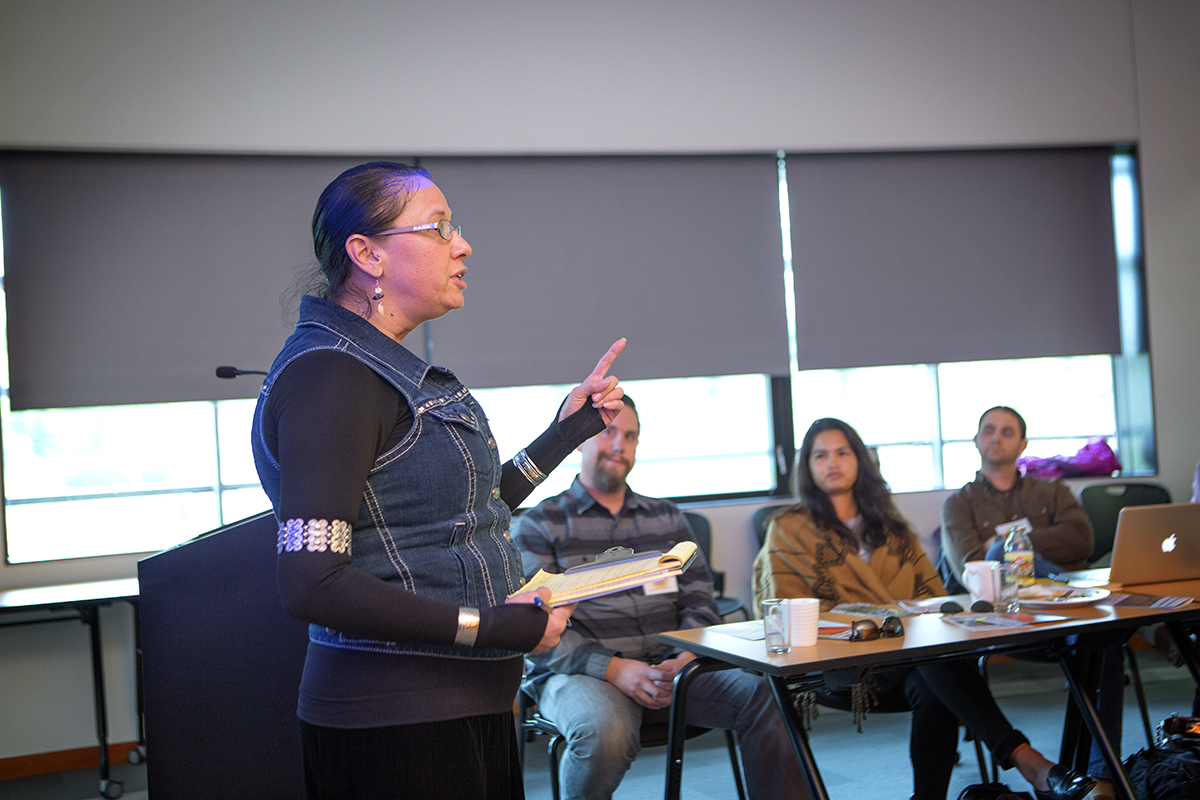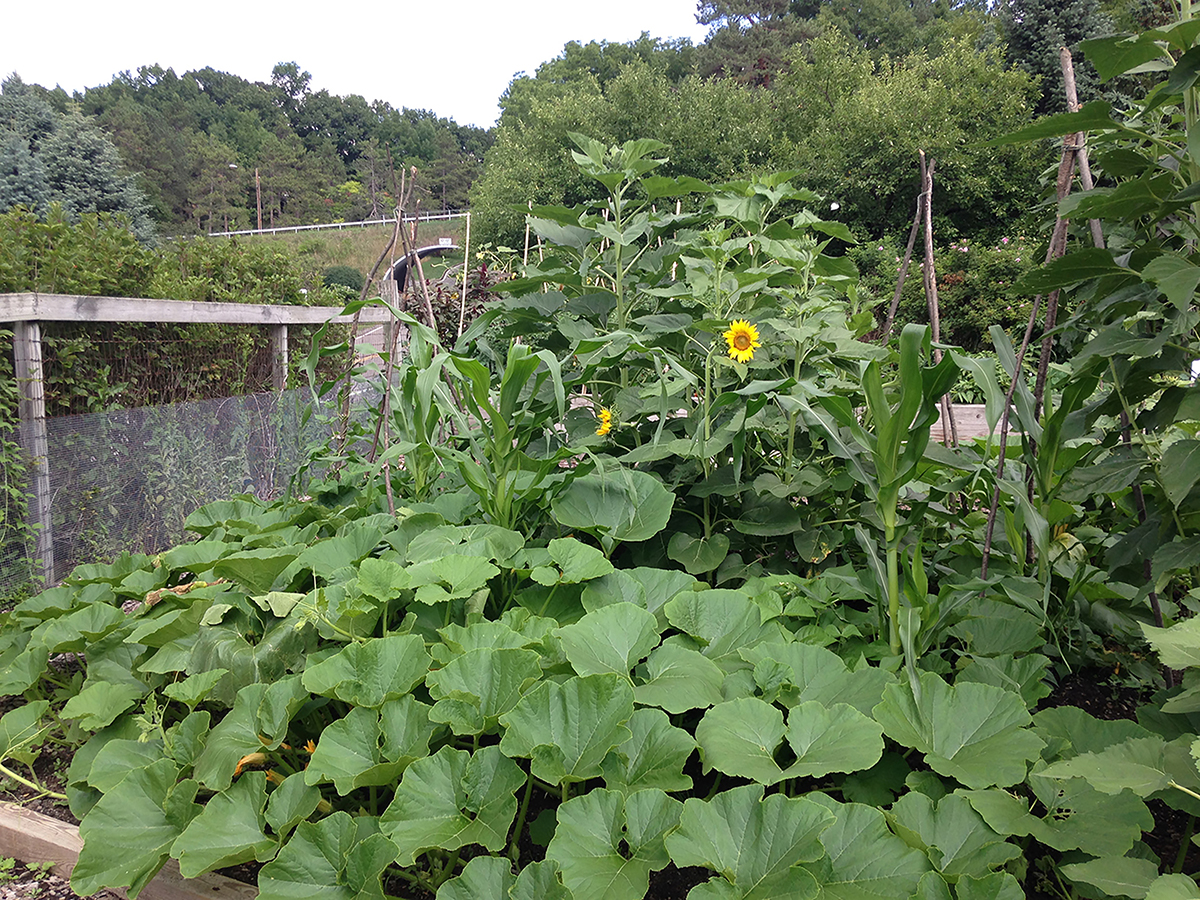Seeds and knowledge shared at 'Planting Moon' gathering
By Daniel Aloi

Cornell researchers and students and growers from Haudenosaunee (Iroquois) communities across New York state discussed indigenous agricultural knowledge, traditions and aesthetic practices at “Ah-Theuh-Nyeh-Hah (The Planting Moon),” a recent symposium and luncheon at Cornell Botanic Gardens’ Nevin Welcome Center.
Indigenous farmers often share seeds with one another to help each community have a successful growing season, in “an ongoing relationship of reciprocity,” said Jolene Rickard, director of the American Indian and Indigenous Studies Program (AIISP) and associate professor of art and the history of art and visual studies.
Knowledge is also shared, she said: “We are all involved in the process of recuperating our entire culture, so each of us has to know a little bit of what the other person knows. How do we move knowledge in our communities from one generation to the next? How do we set the priorities for the future generations? As indigenous peoples we are a storied people.”
Her Tuscarora community is reclaiming the longhouse tradition, she said, in a “process of marrying the storied part of Haudenosaunee culture with our generational experience of growing.”
Rickard, a visual artist, designed the “Ah-Theuh-Nyeh-Hah (The Planting Moon)” installation in the Pounder Vegetable Garden as part of a collaboration between AIISP and Cornell Botanic Gardens that included a related exhibit and public events last fall celebrating the 100-year relationship between Cornell researchers and the Haudenosaunee. Dr. Erl Bates started the Indian Extension Program at Cornell in 1920, offering Haudenosaunee students the opportunity to take short courses in agriculture and home economics.

Also known as the “13 Moons,” the earthwork installation features mounds in the form of a turtle’s back representing the earth’s creation and the 13 moons in the annual lunar cycle, and plants from Haudenosaunee heritage seeds that have been saved and replanted for generations. The work reconsiders the relationship between humans, plants and the environment, Rickard said.
The first planting in June 2016 included tobacco, sunflowers and the traditional “three sisters” (corn, squash and beans). Despite a drought last year, the garden succeeded with regular watering and greenhouse-raised plants replacing those claimed by rodents and birds.
“It resulted in this exuberant display of the three sisters, and one that I used was the squash called Buffalo Creek that my daughter Mia [a Class of 2013 alumna] had traded for at the Six Nations Seed Exchange in 2015,” Rickard said. “I had never grown Buffalo Creek squash before, and we were all amazed that it produced this enormous squash. … We only had 10 seeds from the folks up at Six Nations, and we actually harvested six squash from those 10 seeds.”
Rickard distributed packets of seed from that first harvest of squash among attendees at the symposium, as a repatriation – or “rematriation” – of heritage seeds to Haudenosaunee communities to complete a cycle of the Planting Moon project. “The group of young women I am working with on the West Coast are using the language of ‘rematriation’ … one of my projects is to balance the role of women in our communities as equal contributors as well as being equally recognized,” she said.

“We’re still figuring out what we need to do to create the history around this squash,” Rickard said. “What we found is that in heritage seed catalogs, there are multiple names for the same seed … we’d have to look at the cell structure or biology of this.”
Symposium participants included representatives of the Cayuga, Onondaga, Tuscarora and Seneca nations; Haudenosaunee students from Cornell and Syracuse University; and several members of the Onondaga Farm Crew and Braiding the Sacred, an organization dedicated to preserving traditional knowledge, biocultural diversity and seed keeping, or the conservation of heritage seeds.
The event featured presentations by visiting scholar Amber Meadow Adams on ecology and plants in Haudenosaunee creation narratives; Angela Ferguson on the work of the Onondaga Nation Farm Crew; and associate professor of plant science Jane Mt. Pleasant on the importance of relationships in Haudenosaunee philosophy, food sovereignty and agriculture.
Presenters also included Cornell Botanic Gardens’ director, Christopher Dunn, on the gardens’ mission and vision for the future; and director of education Sonja Skelly, on the new Climate Change Garden.
Media Contact
Get Cornell news delivered right to your inbox.
Subscribe